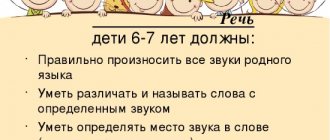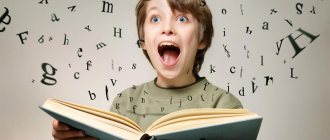so UNT / Preschool education / Teaching six-year-olds based on games and exercises
GAMES AND EXERCISES FOR THE DEVELOPMENT OF CONNECTED ORAL SPEECH
06.04.2013 8346 0
GAMES AND EXERCISES FOR DEVELOPMENT
CONNECTED ORAL SPEECH
WHO WILL TELL IT BETTER?
Didactic task
: identify children’s active vocabulary; develop coherent speech.
Equipment
: a set of plot pictures, a pennant.
Content
. The teacher hands out pictures to the children (or hangs them on the board) and asks them to tell what is depicted on them. You can help the narrator with questions. A pennant is awarded for the best story.
Note. In the second half of the school year, the pictures are distributed in order to children in the same row, and they make up a sequential story. You can suggest making a story based on one picture to several
guys.
DESCRIBE THE SUBJECT
Didactic task
: learn to describe an object, highlighting its essential features; develop intonation expressiveness of speech.
Equipment
: a set of toys (6-8 pcs.), dummies of vegetables and fruits.
Content
. Having chosen one toy, the teacher invites the children to look at it, remember what they know about it, and describe the toy. The teacher gives a sample of the first description. Then two toys are described simultaneously (by comparison). You can describe a toy without showing it. Whoever guesses what is being said becomes the “teacher”. Subsequently, any objects familiar to children are described (aquarium, TV, telephone, etc.).
WHERE WAS THE ROOKIE?
Didactic task
: teach children to introduce descriptive elements into the story; recognize an object by description.
Equipment
: baby books, forfeits.
Content.
The teacher says: “Imagine that a new student has come to our class. He really liked our school. Let him tell you where he went, without naming the places - we’ll guess for ourselves.” Children take turns independently or with the help of a teacher to describe the dining room, library, teacher's room, and medical room. If a child begins to describe a room that is not in the school, he pays a forfeit. Baby books are awarded for the best description.
WHEN DOES THIS HAPPEN?
Didactic task:
to train children in the ability to answer questions in complete sentences; clarify ideas about the seasons.
Equipment:
plot pictures on the theme “Seasons”.
Content.
Participants receive one story picture. The teacher asks the children questions: when do they pick vegetables and fruits? When do the leaves fall? When do children go sledding? The child who has the corresponding picture shows it and answers the teacher’s questions in two or three sentences.
WHO WILL SEE THE MOST?
Didactic task:
identify children's active vocabulary; develop coherent speech.
Equipment:
plot picture.
Content.
The teacher hangs a picture in front of the children and asks them to tell what is depicted on it. Children who cannot tell stories can name two or three main objects. Children with a large vocabulary name an object, its actions or state. Children who speak coherent speech can make four to five sentences. The game continues until everything significant has been named.
Option. Children look at the picture, then it is removed. The guys must tell from memory what is depicted on it. For control, the picture is hung again.
READ AND DESCRIPTE
Didactic task:
practice children reading words of different structures; learn to coherently describe an object without naming it.
Equipment:
word tables.
Content.
Children read words on the board or table, for example:
stork bison apples iron
duck elephant cherry phone
woodpecker rhinoceros plum. TV
etc.
The teacher shows one word, the children must read it to themselves and tell what they know about this subject, for example: “This is a migratory bird, with a red beak and red legs. Found in Belarus. It feeds on frogs. It makes nests on the tops of trees and roofs of houses.” word stork
read.
DESCRIBE WITHOUT SEEING
Didactic task:
improve the ability to describe an object without seeing it.
Equipment:
various items, toys.
Content.
Children remember the objects on the shelf, then turn away. One of the items is removed. The child must determine which object is missing and describe it in several phrases. Initially, there should be no more than four items on the shelf, later the number increases to six to eight. Objects can be selected so that their names contain certain sounds. Best answers are encouraged.
MAKE A RIDDLE
Didactic task:
increase children's active vocabulary; learn to describe an object, highlighting its characteristic properties.
Equipment:
familiar objects and toys.
Content.
The presenter leaves the class. The teacher shows the children a well-known object. Collectively, its characteristic features are identified to compose a riddle. The item is hidden. One of the guys asks the leader a riddle. The presenter will know from the description which item is hidden. Subsequently, children compose a description riddle without the help of a teacher.
MAKE UP A FICTION
Didactic task:
develop monologue speech and imagination of children; help in finding figurative expressions.
Equipment:
stars.
Content.
The game is played after children learn to notice fables and explain them. The teacher gives an example of a fable story. Children listen, notice and name the elements of the fable. Then each child comes up with his own coherent fable story of five to seven sentences. For the best story - an asterisk.
INVITE GUESTS
Didactic task:
teach children to correctly describe the path from home to school and back.
Equipment:
so-printed games on traffic rules.
Content.
The game situation is created using the question: who wants to invite guests and tell them how to get to him? The teacher gives a sample story. Next, the child himself names the streets he is walking along, indicates turns, special signs of paths and alleys, etc. The teacher helps the children, trying not to disrupt the play situation. The game is played at the end of the lesson. For the best stories, children receive printed games based on traffic rules.
ABOUT THE DOLL
Didactic task:
develop children's monologue speech; introduce narrative elements into their speech; test children's ability to hear certain sounds in words.
Equipment:
different dolls.
Content.
Children come up with a story of three or four sentences about the doll Katya.
Each sentence must contain a word with the sound k .
The teacher gives a sample story.
Words with the sound k
are analyzed. Whoever comes up with the best story plays with the doll that day or gives it to a friend to play with. Later, the children come up with a story about the doll Rita, etc.
LET'S COOK LUNCH
Didactic task:
teach consistency in the story; develop monologue speech.
Equipment:
forfeits.
Content.
Children, while waiting for guests, “cook” some “dish”. Children must list all their actions in order. The teacher’s corrections are playful in nature: “Is it tasty?” "No!" - the children answer and list what the cook forgot: salt, pepper, etc. For each mistake, the children pay a forfeit.
LOCAL RADIO
Didactic task:
develop coherent speech, observation, memory; promote the manifestation of a sense of humor in children's speech.
Equipment:
forfeits.
Content.
The teacher says that today the announcer will make an important announcement. He will describe a lost child, and we must find the one who is lost. The teacher gives a sample message (describes one of the children), then appoints a speaker. It is necessary to note the characteristic features of the appearance of the lost person. If the announcer gave a description by which the children did not recognize anyone, they answer: “We don’t have such a child!” Then the announcer pays a forfeit. Forfeits are played out at the end of the game.
WHAT TOY?
Didactic task:
give a sample of sequential familiarization with the subject (with its verbal description); exercise the ability to examine and describe a similar object.
Equipment:
two nesting dolls, two trucks, etc. (the toys are the same, they differ only in details).
Content.
The teacher describes the nesting doll, giving the children an example of sequential familiarization with the subject. Children must guess which of the two nesting dolls we are talking about. Whoever guessed correctly will describe another pair of objects according to the model. In the future, the child can also describe the first object.
LET'S MAKE A STORY TOGETHER
Didactic task:
introduce elements of reasoning into children’s speech (i.e., reporting facts that are in cause-and-effect relationships); learn to work together.
Equipment:
a set of pictures, the plots of which reflect the work processes and rest of people at different times of the year: “Haymaking”, “At the Post Office”, “Harvest Day”, etc.
Content.
The teacher distributes the pictures in rows (each row works with a set of pictures on one topic), invites the children to look at them carefully and tell what they see in the picture. From individual stories, a general one is compiled. The game is played as a competition between the rows, and the winning team is revealed.
Reasons for the delay in the formation of coherent speech in children
To determine the level of development of coherent speech, you need to analyze compliance with the age criteria listed above, that is, make a kind of diagnosis. It should be carried out in a playful way, without focusing the child’s attention on the result, without making comments, without correcting, without teaching. Just create a situation and observe the behavior and speech of a preschooler.
Difficulties and difficulties in speech development can occur in children for medical reasons:
- pathology of intrauterine development (mother's exposure to infectious diseases, intense toxicosis);
- birth injuries (asphyxia, premature birth, infection, etc.);
- childhood head trauma, especially in the area of speech zones;
- hearing or speech impairment (the latter is diagnosed by age 5).
There are also social reasons that slow down the development of coherent speech in a child:
- pedagogical neglect - they do not work with the child or the child exhibits behavioral disorders (“difficult child”);
- lack of communication in a family - the lack of direct, close communication between all its members, when several people simply exist under one roof;
- change of place of residence, especially in a foreign-language environment - if at home they speak one language, in a child care center and on the street - in another, the child experiences difficulties in mastering speech skills.
Excessive care can also lead to speech delays, since the child simply does not need to speak if his wishes are guessed and instantly fulfilled.
As a rule, by the age of 5-6 years a child can:
- consistently answer questions;
- compose short narratives based on illustrations;
- describe your impressions of what you saw;
- convey the content of what was heard or seen from memory;
- come up with a continuation of a fairy tale, fantasize.
But in order for the result to meet age requirements, it is necessary to pay enough attention to communication and activities with the child at each stage of growing up.








